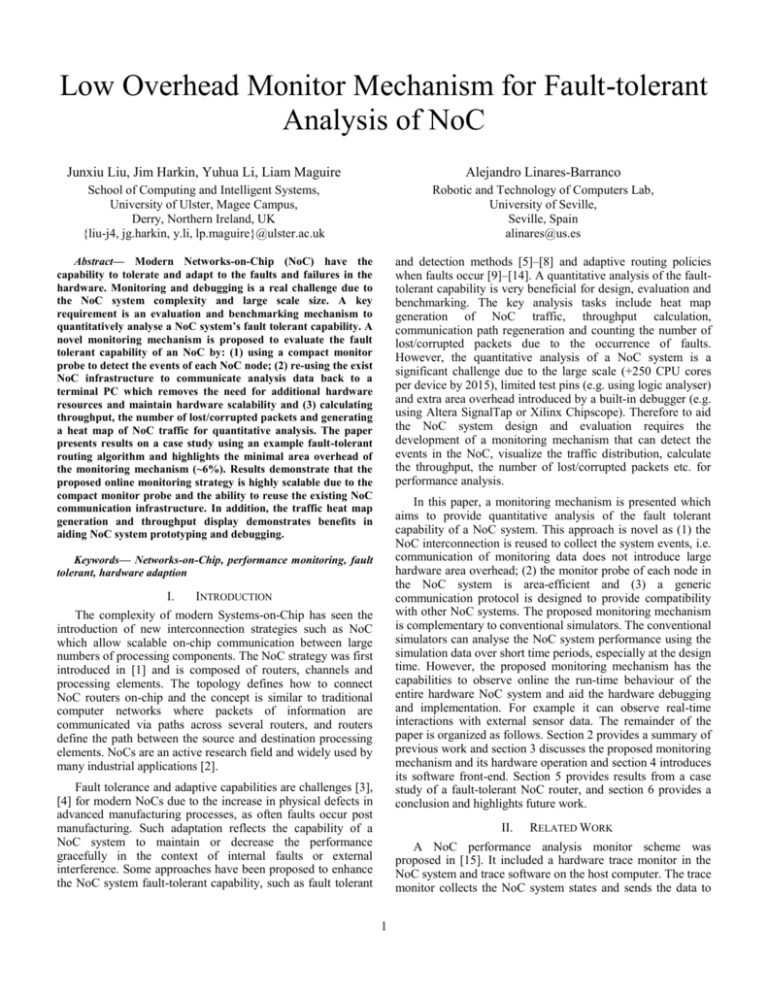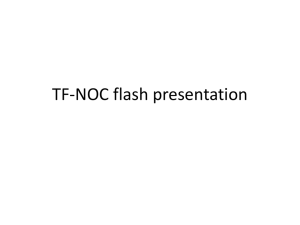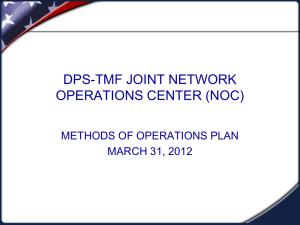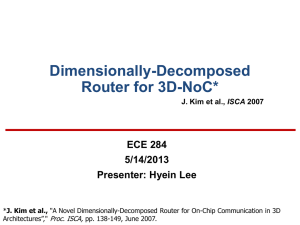IEEE_MCSoC2014_camera_ready
advertisement

Low Overhead Monitor Mechanism for Fault-tolerant
Analysis of NoC
Junxiu Liu, Jim Harkin, Yuhua Li, Liam Maguire
Alejandro Linares-Barranco
School of Computing and Intelligent Systems,
University of Ulster, Magee Campus,
Derry, Northern Ireland, UK
{liu-j4, jg.harkin, y.li, lp.maguire}@ulster.ac.uk
Robotic and Technology of Computers Lab,
University of Seville,
Seville, Spain
alinares@us.es
and detection methods [5]–[8] and adaptive routing policies
when faults occur [9]–[14]. A quantitative analysis of the faulttolerant capability is very beneficial for design, evaluation and
benchmarking. The key analysis tasks include heat map
generation of NoC traffic, throughput calculation,
communication path regeneration and counting the number of
lost/corrupted packets due to the occurrence of faults.
However, the quantitative analysis of a NoC system is a
significant challenge due to the large scale (+250 CPU cores
per device by 2015), limited test pins (e.g. using logic analyser)
and extra area overhead introduced by a built-in debugger (e.g.
using Altera SignalTap or Xilinx Chipscope). Therefore to aid
the NoC system design and evaluation requires the
development of a monitoring mechanism that can detect the
events in the NoC, visualize the traffic distribution, calculate
the throughput, the number of lost/corrupted packets etc. for
performance analysis.
Abstract— Modern Networks-on-Chip (NoC) have the
capability to tolerate and adapt to the faults and failures in the
hardware. Monitoring and debugging is a real challenge due to
the NoC system complexity and large scale size. A key
requirement is an evaluation and benchmarking mechanism to
quantitatively analyse a NoC system’s fault tolerant capability. A
novel monitoring mechanism is proposed to evaluate the fault
tolerant capability of an NoC by: (1) using a compact monitor
probe to detect the events of each NoC node; (2) re-using the exist
NoC infrastructure to communicate analysis data back to a
terminal PC which removes the need for additional hardware
resources and maintain hardware scalability and (3) calculating
throughput, the number of lost/corrupted packets and generating
a heat map of NoC traffic for quantitative analysis. The paper
presents results on a case study using an example fault-tolerant
routing algorithm and highlights the minimal area overhead of
the monitoring mechanism (~6%). Results demonstrate that the
proposed online monitoring strategy is highly scalable due to the
compact monitor probe and the ability to reuse the existing NoC
communication infrastructure. In addition, the traffic heat map
generation and throughput display demonstrates benefits in
aiding NoC system prototyping and debugging.
In this paper, a monitoring mechanism is presented which
aims to provide quantitative analysis of the fault tolerant
capability of a NoC system. This approach is novel as (1) the
NoC interconnection is reused to collect the system events, i.e.
communication of monitoring data does not introduce large
hardware area overhead; (2) the monitor probe of each node in
the NoC system is area-efficient and (3) a generic
communication protocol is designed to provide compatibility
with other NoC systems. The proposed monitoring mechanism
is complementary to conventional simulators. The conventional
simulators can analyse the NoC system performance using the
simulation data over short time periods, especially at the design
time. However, the proposed monitoring mechanism has the
capabilities to observe online the run-time behaviour of the
entire hardware NoC system and aid the hardware debugging
and implementation. For example it can observe real-time
interactions with external sensor data. The remainder of the
paper is organized as follows. Section 2 provides a summary of
previous work and section 3 discusses the proposed monitoring
mechanism and its hardware operation and section 4 introduces
its software front-end. Section 5 provides results from a case
study of a fault-tolerant NoC router, and section 6 provides a
conclusion and highlights future work.
Keywords— Networks-on-Chip, performance monitoring, fault
tolerant, hardware adaption
I.
INTRODUCTION
The complexity of modern Systems-on-Chip has seen the
introduction of new interconnection strategies such as NoC
which allow scalable on-chip communication between large
numbers of processing components. The NoC strategy was first
introduced in [1] and is composed of routers, channels and
processing elements. The topology defines how to connect
NoC routers on-chip and the concept is similar to traditional
computer networks where packets of information are
communicated via paths across several routers, and routers
define the path between the source and destination processing
elements. NoCs are an active research field and widely used by
many industrial applications [2].
Fault tolerance and adaptive capabilities are challenges [3],
[4] for modern NoCs due to the increase in physical defects in
advanced manufacturing processes, as often faults occur post
manufacturing. Such adaptation reflects the capability of a
NoC system to maintain or decrease the performance
gracefully in the context of internal faults or external
interference. Some approaches have been proposed to enhance
the NoC system fault-tolerant capability, such as fault tolerant
II.
RELATED WORK
A NoC performance analysis monitor scheme was
proposed in [15]. It included a hardware trace monitor in the
NoC system and trace software on the host computer. The trace
monitor collects the NoC system states and sends the data to
1
the PC software for the performance evaluation. It uses
Ethernet to collect the data in real-time. However, the NoC
operates at a relative low clock frequency (25MHz) to allow
the data collection in real-time. The monitor also needs to
connect every channel through additional, dedicated wires
which prohibits scalability for a large system. An industrial
NoC emulation and verification environment, namely
NOCEVE, was proposed in [16]. It can analyse the
performance of large-scale multi-FPGAs including traffic
distribution, latency and throughput etc.. Two models of realtime visualization and post-execution data analysis were
proposed. A run-time monitoring mechanism was also
proposed in [17] to decide the optimal NoC buffer size and
capture system behaviour. A monitoring probe module was
embedded inside each router. All the monitoring probe
modules send traffic information to a global interface which is
responsible for gathering all the snapshot data. They are
connected by a dedicated point-to-point (P2P) connection
which prohibits system scalability. Similarly, a configurable
monitor was proposed in [18] where a probe component was
embedded in the network interface to observe events between
the router and processing element. The events were processed
in the pre-processing module and then sent to a probe
management unit for collection. However the probes
introduced a high area overhead such that a 4 multi-purpose
probe was approximately equal to 55% of the total area of the
network interface and router.
investigate such a monitoring mechanism as fault tolerance and
adaptive capabilities are of paramount importance with ever
increasing density of large scale electronic systems.
III.
LIGHT WEIGHT MONITOR PROBE AND STATISTICS
NODE IN THE NOC
In our previous work [8], [13], [14], [19], the authors
developed a NoC router design, namely EMBRACE, which
demonstrated a traffic-aware and online fault testing equipped
router. This section outlines the monitor probe design based on
the EMBRACE router and the communication protocol
between the NoC and the computer.
A. Regular NoC node
Fig. 1.(a) presents the overall system structure. A remote
server is used to compile the HDL code of the NoC system due
to the long synthesis time of the hardware. The server is
connected to a host computer via Ethernet. A Jtag server
operates on the host computer which provides the bit-stream
download and debugging service for the remote server. A NoC
system is implemented on the FPGA board and the host
computer is connects to the FPGA. The monitoring software
runs on the host computer and provides analysis of the NoC
fault tolerant capability based on traffic data from the NoC on
the FPGA.
The example NoC system in the Fig. 1.(a) is a 2D-mesh
(DIMx ∗ DIMy ) NoC system and is composed of NoC nodes,
probe modules and a single statistics node. Each NoC node is
positioned by one pair of coordinates and is connected to the
neighbouring router nodes through channels at North/E/S/W
directions. The NoC node includes one router and one
processing element (PE). A probe module is embedded in the
PE but it collects all the traffic events of the corresponding
router on all of the directions including N/E/S/W and the
events of the PE at the local connection. For example, in Fig.
1.(a) the probe in PE(2,2) collects all the events of router(2,2)
on its N/E/S/W directions and the local connection events of
PE(2,2). The PE obtains the event data from the probe and then
constructs the statistics packets which are forwarded to
statistics node (STAT). The STAT node is connected to the
complete NoC system. The coordinate of the STAT node in
In summary, current approaches have the aforementioned
weaknesses of (1) they do not provide the quantitative analysis
required for a fault-tolerant capability [17]; (2) prohibit
scalability due to large area overheads of monitor trace module
and data connection for events collection in the NoC system
[15], [18]; and (3) commercial copyright as they are not open
source [16]. To be available to the general public via open
source can promote research by supporting independent review
and evolution of code. For a modern NoC monitoring
mechanism, several key functions need to be addressed:
capability to provide analysis on NoC fault tolerance,
scalability – do not have an impact on area overhead, and
accessibility (open-source to NoC community) to aid others in
designing and debugging the NoC. It is now timely to
NoC system
1
2
3
Router
Router
Router
...
DIMx
Remote Server
1
Router
Regular Application Packet Layout
P
P
P
P
PE
PE
PE
PE
Header (4 Bits) Des Addr (8 Bits)
(DIMx+1, 2)
Network connection
2
Router
Router
Router
STAT
Router
Upload the NoC
traffic information
JTAG debug cable
PE
PE
Router
MSB
1
Host Computer
(Monitor software)
P
PE
Router
PE
P
P
PE
Router
Router
P
Router
DIMy
PE
PE
P
.
.
.
Router
P
P
P
PE
3
Router
Router
Router
Src Addr (8 Bits) (M*) Payload (16 Bits)
Fault Detection Application Packet Layout
Test Vectors
Header Information
Running Mode
The number of sent packets (PE)
The number of received packets (PE)
The number of received packets (N)
The number of received packets (E)
The number of received packets (S)
The number of received packets (W)
Testing Mode
Value
0001
0010
0011
0100
0101
0110
0111
1xxx
Target (Altera DE4)
*M bit only be valid if the Header is in the range 0010-0111.
PE
P
PE
P
P
P
PE
PE
P : Probe
(a)
(b)
Fig. 1. Example NoC monitoring setup: (a) System structure; (b) The packet layout of the NoC
2
Fig. 1.(a) is (DIMx + 1,2). It is responsible for collecting the
statistics data from each NoC node (router/PE) and uploading it
to the computer. In order to differentiate from the STAT node,
all other nodes in the NoC except STAT are referred to as
regular nodes.
can be used for counting the event, i.e. the maximum number
of traffic events is 215 = 32,768 , however this can be
increased. Assume the NoC system clock frequency is
100MHz, therefore the window time can be up to 0.33 µs. Note
that window time can be longer if the payload width is set to be
wider (16-bit is used as an example size). Note that in this
approach, the monitor probe collects and sends the statistics
data to the STAT node synchronously. The example
application running in the NoC hardware is a spiking neural
network (SNN) [13], which operates at a very low frequency
e.g. the inter-spike interval in the order of milliseconds. As the
average firing rate is low, the channel traffic status is idle at
most of time, which allows all the statistic packets reach the
STAT node within the data collection time. However, if the
regular application traffic is heavy, an independent physical
communication infrastructure, e.g. the dedicated channels in
[15], [16], should be employed to collect the statistics data.
Similar to the computer network, the NoC uses a specific
packet format to forward the data across the network. The
packet layout of EMBRACE is defined in Fig. 1.(b). When the
MSB is ‘1’, the packet is used as a test vector for online fault
detection. The fault detection packets are generated at each
router and sent across the local N/E/S/W channels. However, if
the MSB is ‘0’, the packet is a regular application packet [8]. In
the regular application mode of operation, the packet can have
several functions - defined by the packets header between
values (0001)2 and (0111)2 . When the packet header
contains (0001)2 , it is classed as a normal packet containing
data for the regular application mapped to the NoC; if the
header is between (0010)2 to (0111)2 , the packet is classed as
a statistics packet which contains traffic event data on the
number of packets a PE sent/received, the number of packets a
router received at N/E/S/W, respectively. For the statistics
packet, the most significant bit (M) of the payload (see top
packet layout of Fig.1 (b)) is used to indicate the channel
status. If it is ‘1’, the channel is defined as faulty; if it is ‘0’, the
channel is fault-free. The setting of the M bit is controlled via
the online test mechanism available in the example NoC [8].
Let’s take an example to illustrate the packet layout definition.
Assume the STAT node is (5,2) in a 4x4 2D-mesh NoC;
regular node (2,2) sends packets to (3,2) and node (2,1) sends
packets to (2,2) as depicted in Fig. 1 (a) where DIMx = 4,
DIMy = 4 . If node (2,2) sends a packet and the packet is
(800000001)16 , it is defined as a test packet (MSB is ‘1’) and
therefore performs testing on the channel between NoC node
(2,2) and (3,2); if the packet is (132220251)16 , then it is a
normal packet which means the destination is (3,2), the source
is (2,2) and the data application payload is (0251)16 . If the
packet is (252220005)16 , then it is a statistic packet which
means the packet is sending it to the STAT node (5,2), where it
define the source node as (2,2) and that 5 packets were sent by
PE(2,2). If the packet is (452220008)16 , then it is again a
statistic packet where the source node is (2,2) and the router
(2,2) has received 8 packets via its northern channel. If the
packet is (652228000)16 , then it is classed as a statistic
packet where the source node is (2,2) and its southern channel
of (2,2) is defined as faulty as the M bit of payload is ‘1’.
B. STAT node
The STAT node is responsible for receiving statistics data
from all regular nodes in the NoC and uploading it to the PC.
The structure of the STAT node is presented in Fig. 3. It
includes a FIFO, a statistics stream generator and a
communication interface. The FIFO is required as the packet
receive rate from the regular nodes and the byte stream send
rate to the computer can differ; the statistics stream generator is
responsible for converting the 36-bit statistics packets from the
NoC to an 8-bit byte streams for uploading to the PC. The
communication interface can be UART, SPI2USB or Ethernet.
The UART is a light weight communication protocol which
does not introduce much area overhead; SPI2USB was
implemented in [20] which has a high speed rate but requires a
microcontroller as a converter; Ethernet is the highest speed
protocol however it requires a soft core processor on the FPGA
due to its complex protocol, therefore it has large area
overhead [15]. However, these three connection protocols can
be selected based on the requirement of application. In this
paper, the light weight UART protocol is used.
window time
Finished = 1
Finished = 0
Idle
Collect the
statistics data
reset
Finished = 0
Finished = 1
Based on the packet layout definition, the regular
application, test vector and statistics packets can be forwarded
correctly across the same NoC network without any additional
interconnect. Extra area overhead is not introduced as the
statistic data is forwarded across the existing NoC network.
The work flow of the proposed hardware monitoring system is
presented in Fig. 2. After the NoC is reset, the regular (NoC)
node is in the idle state until it starts to run an application task.
After the application has run for a time period (defined as
window time), the application is interrupted and the monitor
probe inside the PE collects the statistics data and then sends it
to the STAT node. In this approach, the payload of the packets
is 16-bit in length. In addition, the M bit of the payload is used
to indicate the channel status. Therefore, a maximum 15 bits
Send the
statistics data
Fig. 2. The work flow of regular node in the NoC
STAT Node
Router
FIFO
empty Statistics
data
stream data
read Generator
UART,
SPI,
or
Ethernet
Fig. 3. The statistics node structure
3
RS232
SPI2USB
Ethernet
PC
between the input and output channel is 𝑀𝑚 and the margin
between the output channel and router bottom edge is 𝑀𝑏 .
The STAT node and computer communicate with each
other based on a communication protocol which is illustrated in
Fig. 4. The communication begins with 0x42; the next byte is
the type of statistical data which is consistent with Fig. 1.(b),
e.g. the value of 2 represents the number of packets PE has
transmitted; the third byte is the STAT node address; the fourth
byte is the source node address which sent the statistics
packets; the next two bytes of Data (byte 1 and 2) correspond
to the payload of statistics packets; and the final byte is 0x4C.
The software hosted on the computer can analyse the NoC
traffic events and provide a quantitative result on system
performance.
To plot the router and channels in map, the start point of
every router and channel should be identified. The physical
position is defined by (1), assume that: one node (i, j) in a
𝐷𝐼𝑀𝑥 ∗ 𝐷𝐼𝑀𝑦 NoC system, (𝑥𝑜 , 𝑦𝑜 ) is the start point of the
traffic heat map in the x/y-axis. R(i, j) is the start point of router
(i, j) and N/E/S/WIC(i, j) is the start point of the
Northern/E/S/W input channel of router (i, j). Based on the size
parameters in Fig. 5 and coordinates in (1), any size of NoC
system can be visualised successfully.
x
STAT stream header Statistics stream header: 0x42
STAT stream type
(xo, yo)
NoC system traffic heat map plot area
Statistics stream type: 0x02~0x07
i-1
STAT node address Statistics node address
Packet src address
i
i+1 i+2
j-1
User data region
Source node sent the statistics data
j
Data Byte 1
Statistics data byte 1
j+1
Data Byte 2
Statistics data byte 2
j+2
Rw
Mu
Cl
Mm
Statistics packet tail: 0x4C
Rh
STAT stream tail
One node
Fig. 4. Data exchange format between STAT node and computer
Mb
Cw
IV.
NOC SYSTEM PERFORMANCE ANALYSIS SOFTWARE
channel
Performance analysis software for the NoC system was
investigated for the host PC. It provides several functions in
quantitatively evaluating NoC performance including
throughput, the number of lost/corrupted packets calculation
and the heat map generation of NoC traffic. In particular, the
software highlights were faults have been detected and the loss
of packets as a result. This enables design exploration and
evaluation of adaptive NoC routing algorithms algorithm when
faults occur.
y
Fig. 5. The size parameters of components in the NoC system
Secondly, a colour filled scheme for the channel is
employed to generate the heat effects in the map. The darker
the colour of a channel, the heavier the traffic is. The colour is
presented in the RGB data format, for example, if RGB = (0, 0,
0), the colour is black. The colours between red and yellow are
used to present the traffic load in this approach. If the channel
is red, the traffic is heavy and if yellow, the traffic is light. For
the colour between red and yellow, the R and B values can be
set to 237 and 47; only the Green value needs to be changed.
Therefore, the 𝑅𝐺𝐵 = (237, 𝐺, 47) where G is the only value
needs to be set and 0 ≤ 𝐺 ≤ 255. If G= 0, the colour is red; if
G= 255, the colour is yellow. The NoC router sends one packet
per clock cycle (a packet only contains one flit in this approach
– as defined by the example SNN application [13] used in this
study). For a given window time of N clock cycles, the
maximum number of packets that can be sent or received is
equal to N. Assume that the number of traffic events in Fig. 4 is
𝑅𝑒𝑣𝑒𝑛𝑡𝑠 , the G value can be calculated by (2). For example, if
the window time is N=300 clock cycles and the number of
events is 𝑅𝑒𝑣𝑒𝑛𝑡𝑠 = 260, then G=34 (by (2)) and RGB (237,
34, 47) will be used to fill the channel colour. This colour is
A. Traffic heat map generation
The traffic heat map feature of the software enables
researcher to quickly identify busy (hot-spot) nodes, congested
and faulty channels. The clear view of the heat map helps
designers in optimising the mapping of application tasks to the
different PEs, and also designing more efficient routing
algorithms etc. to enhance the fault-tolerant capability of the
NoC.
Firstly in the software, the physical parameters of routers
and channels need to be identified as part of the visualisation
parameters of the data on the NoC. Each node consists of one
router and 4 input channels in the NoC system. The size
parameters of the routers and channels are defined in Fig. 5 the width of a router is 𝑅𝑤 , the height of router is 𝑅ℎ ; the width
of a channel is 𝐶𝑤 , the length of channel is 𝐶𝑙 ; the margin
between the channel and router top edge is 𝑀𝑢 , the distance
𝑅(𝑖, 𝑗) = (𝑥𝑜 + 𝑖 ∗ (𝑅𝑤 + 𝐶𝑙 ), 𝑦𝑜 + 𝑗 ∗ (𝑅𝑤 + 𝐶𝑙 ))
𝑁𝐼𝐶(𝑖, 𝑗) = (𝑥𝑜 + 𝑖 ∗ (𝑅𝑤 + 𝐶𝑙 ) + 𝑀𝑢 , 𝑦𝑜 + 𝑗 ∗ 𝑅𝑤 + (𝑗 − 1) ∗ 𝐶𝑙 ), 𝑗 ≠ 0
𝐸𝐼𝐶(𝑖, 𝑗) = (𝑥𝑜 + (𝑖 + 1) ∗ 𝑅𝑤 + 𝑖 ∗ 𝐶𝑙 , 𝑦𝑜 + 𝑗 ∗ (𝑅𝑤 + 𝐶𝑙 )) + 𝑀𝑢 , 𝑖 ≠ 𝐷𝐼𝑀𝑦 − 1
𝑆𝐼𝐶(𝑖, 𝑗) = (𝑥𝑜 + 𝑖 ∗ (𝑅𝑤 + 𝐶𝑙 ) + 𝑀𝑢 + 𝐶𝑤 + 𝑀𝑚 , 𝑦𝑜 + (𝑗 + 1) ∗ 𝑅ℎ + 𝑗 ∗ 𝐶𝑙 ), 𝑗 ≠ 𝐷𝐼𝑀𝑥 − 1
{𝑊𝐼𝐶(𝑖, 𝑗) = (𝑥𝑜 + 𝑖 ∗ 𝑅𝑤 + (𝑖 − 1) ∗ 𝐶𝑙 , 𝑦𝑜 + 𝑗 ∗ (𝑅𝑤 + 𝐶𝑙 ) + 𝑀𝑢 + 𝐶𝑤 + 𝑀𝑚 ), 𝑖 ≠ 0
4
(1)
1. Control panel
3.2. Throughput 3D display
4. # of lost, corrupted
packets
3.1. Throughput
calculation
2. Traffic heat map
Received packets
Fig. 6. Monitor software interface
close to red which means the traffic is heavy. In addition, the
M bit of payload, shown in Fig. 1.(b), is used to indicate the
status of a channel. If it is ‘0’, the channel is fault-free.
However, If it is ‘1’, the channel is faulty and the RGB is set to
(0,0,0), i.e. the colour black.
C. The number of loss/corrupted packets calculation
The symbols of 𝑅𝑁/𝐸/𝑆/𝑊/𝐿 and 𝑆𝑁/𝐸/𝑆/𝑊/𝐿 are defined as
the number of received(R)/sent(S) packets through
North/E/S/W/Local port. The total number of faults
experienced in the NoC is reflected by the number of packets
which are lost in communication due to the fault, e.g. a fault in
a channel etc. We calculate the impact, F, from the faults on
packet transmission, using (5). F is equal to the total number of
packets a router receives on the N/E/S/W/L ports, minus the
total number of packet the router has sent. For a fault-free
router, the number of total received packets is equal to the
number of packets sent. For a faulty router the total number of
transmitted and received packets will vary.
𝑅𝑒𝑣𝑒𝑛𝑡𝑠
(2)
)
𝑁
The router in this paper uses the distributed adaptive
routing algorithm [8], [13]. Every port (N/E/S/W and local) can
send and receives packets at the same time. The colour filled
scheme is applied to the input and output directions of all the
ports. Based on the coordinates definition and colour filled
scheme, a traffic heat map is generated. The heat map shows
the overall traffic status in a visualized manner and enables
behaviour analysis of routing algorithm when faults occur.
𝐺 = 255 ∗ (1 −
𝐹 = (𝑅𝑁 + 𝑅𝐸 + 𝑅𝑆 + 𝑅𝑊 + 𝑅𝐿 ) −
(𝑆𝑁 + 𝑆𝐸 + 𝑆𝑆 + 𝑆𝑊 + 𝑆𝐿 )
B. Throughput calculation
Each NoC router has four ports to connect neighbouring
nodes and a local port to connect the local PE. The router
works on a clock frequency of 100MHz and the channel width
is 36-bit, therefore the maximum throughput for a single port is
3.6Gbps [13]. For a given window time of N clock cycles, the
router throughput, T, can be calculated by (3), where ∑ 𝑅 =
𝑅𝑁 + 𝑅𝐸 + 𝑅𝑠 + 𝑅𝑤 + 𝑅𝐿 , i.e. the number of received packets
through North/E/S/W/Local ports, 𝑓𝑐 is the clock frequency.
The throughput of each node is visualised in a 3D columnformat so clarity across the 2-D mesh.
𝑇=
∑ 𝑅 × 36
× 𝑓𝑐
𝑁
Stuck-at and crosstalk faults are employed in this paper as
they are the most common faults in the NoC (the detailed fault
models can be found in the authors’ previous work [8]). When
a packet is forwarded to a faulty channel with stuck-at fault, it
will be corrupted. However, if the packet is forwarded to a
faulty channel with crosstalk fault, it has a ~90% possibility of
being corrupted and ~10% possibility of being lost (e.g. due to
being overwritten inside the buffer, corrupted channels, soft
errors) based on the study performed in [21]. Lost packets
never reach their destination while corrupted packets do
however the integrity of the packet payload is no longer
guaranteed. Therefore, the number of lost (𝐿𝑝 ) and corrupted
packets (𝐶𝑝 ) can be calculated by (6). The fault model can be
selected in the software interface to allow performance
evaluation under different fault conditions.
(3)
Average throughput is also used to reflect the system
performance. It is defined by (4), where the 𝑇𝑎𝑣𝑔 is the average
throughput of the system and 𝑇(𝑖, 𝑗) is the throughput of router
(i,j).
𝑇𝑎𝑣𝑔 = ∑
𝐷𝐼𝑀𝑥
𝑖=1
𝐷𝐼𝑀𝑦
∑
𝑗=1
𝑇(𝑖, 𝑗) /(𝐷𝐼𝑀𝑥 ∗ 𝐷𝐼𝑀𝑦 )
(5)
0, 𝑠𝑡𝑢𝑐𝑘 − 𝑎𝑡 𝑓𝑎𝑢𝑙𝑡
𝐿𝑝 = {
0.1 ∗ 𝐹, 𝑐𝑟𝑜𝑠𝑠𝑡𝑎𝑙𝑘 𝑓𝑎𝑢𝑙𝑡
𝐹, 𝑠𝑡𝑢𝑐𝑘 − 𝑎𝑡 𝑓𝑎𝑢𝑙𝑡
𝐶𝑝 = {
0.9 ∗ 𝐹, 𝑐𝑟𝑜𝑠𝑠𝑡𝑎𝑙𝑘 𝑓𝑎𝑢𝑙𝑡
(4)
(6)
The traffic heat map, throughput and the number of
lost/corrupted packets provides efficient metrics to analyse the
fault-tolerant capability of a NoC system. The current version
5
1
2
3
4
5
6
7
8
1
2
3
4
5
6
7
8
4
5
6
4
3
2
1
8
0
4
3
2
1
8
0
1 2 3 4 5 6 7 8
7
DIMy
3
DIMy
Throughput [Gbps]
2
Throughput [Gbps]
1
1 2 3 4 5 6 7 8
(a)
DIMx
(b)
DIMx
8
Traffic pattern (a)
Traffic pattern (b)
Throughput [Gbps]
8
3
6
4
2
6
8
0
DIMy
4
5
4
3
2
1
1 2 3 4 5 6 7 8
(c)
DIMx
8
Traffic pattern (c)
8
0
1 2 3 4 5 6 7 8
7
DIMy
2
Throughput [Gbps]
1
(d)
DIMx
Traffic pattern (d)
1
5
3
2
1
6
8
0
DIMx
8
Traffic pattern (e)
(f)
(e)
DIMx
(f)
In this paper a case study on an 8x8 (64 cores) NoC system
of 2D-mesh topology was implemented in the Altera DE4
development board (Stratix EP4SGX530KH4C2 FPGA). Each
router implements a fault-tolerant NoC routing algorithm [8]
developed by the authors. At the local port of each router, a PE
is attached which encompasses a packet generator. The packets
generator generates the packets according to the packet layout
shown in the Fig. 1.(b) and controls the number of packets
issued to the local router. Six traffic patterns listed in
A CASE STUDY AND EVALUATION
TABLE I. THE TRAFFIC PATTERNS OF BENCHMARKING
(e)
8
1 2 3 4 5 6 7 8
faults in the NoC. Note faults are injected into the NoC
channels using fault injectors [8], [22] and are not facilitated
via the software interface. In this approach, the UART is
employed as it has a small area overhead in the NoC.
This section presents an example case study using the
proposed monitoring mechanism. Fig. 6 shows the monitor
software interface which runs on a host PC. Its main role is to
provide quantitative analysis of the NoC performance, e.g.
evaluate the NoC routing policy under real-time traffic and
fault conditions. The software provides several facilities
including 1) a control panel where the NoC system size and
running time are defined; 2) a traffic heat map which is
generated according to the NoC traffic; 3) average throughput
calculation and 3D display of throughput, and 4) the number of
lost/corrupted packets calculation to define the impact from
(d)
1
Fig. 8. The throughput of NoC routers displayed in 3-D column
of the tool supports mesh and torus topologies however other
topologies can be supported via minimal modification. An
example is given in the next section to illustrate how the
physical hardware monitoring mechanism provides data to the
software for analysis.
#
(a)
(b)
(c)
2
Traffic pattern (f)
Fig. 7. Traffic heat map of different traffic patterns
V.
3
0
1 2 3 4 5 6 7 8
7
4
DIMy
4
4
Throughput [Gbps]
3
DIMy
Throughput [Gbps]
2
Traffic patterns
(8,*)->(*,8)
(8,*)->(*,8), varied PIR
(6,2)->(2,6), (3,2)->(2,3)
(6,2)->(2,6),
WC(6,2) is faulty
(6,2)->(2,6),
WC(6,2), WC(5,3~6) are faulty
(6,2)->(2,6),
NC&SC(3~4,2), WC(3,2) are faulty
6
1
2
3
4
5
6
7
8
1
2
3
4
5
6
7
8
Fig. 8. The throughput of
NoC routers displayed in 3D column
1
4
5
6
3
2
1
8
0
1 2 3 4 5 6 7 8
7
DIMx
8
Traffic pattern (a)
Traffic pattern (b)
1
4
5
6
7
4
3
2
DIMy
Throughput [Gbps]
2
3
1
8
0
1 2 3 4 5 6 7 8
8
Traffic pattern (c)
Traffic pattern (d) DIMx
1
2
3
Throughput [Gbps]
8
4
6
5
4
6
2
7
8
0
1 2 3 4 5 6 7 8
8
Traffic pattern (e)
Traffic pattern (f) DIMx
Fig. 7. Traffic heat map of different traffic
patterns
4
The traffic patterns in
3
2
DIMy
Throughput [Gbps]
were employed to evaluate the monitoring mechanism in
this case study. These traffic patterns were chosen as they can
evaluate the capability of congestion-avoid and fault-tolerance
(a)
of the NoC system. All 6 traffic scenarios were injected into
the NoC on the FPGA, executed in real-time and the resultant
statistics data transfer to the software for analysis. Traffic
pattern (a) presents a transpose traffic where node (8,i) sends
packets to (i,8), i ∈ [1,7]; (b) presents a different varied packet
injection rate (PIR) of 20 and 1 respectively (i.e. the packets
are sent every 20 and 1 clock cycles); (c) present a congested
traffic where (6,2) and (3,2) send packets to (2,6) and (2,3)
respectively. A congestion will occur in the western output
channel (WC) of (3,2); (d) presents a traffic pattern with a
single faulty channel. Node (6,2) sends packets to (2,6) and
(b)
WC of (6,2) is faulty; (e) presents a traffic pattern with
multiple faulty channels. The source/destination nodes are the
same as (d). However, the WCs of (6,2), (5,3), (5,4), (5,5),
(5,6) are faulty and (f) presents a clustered faulty region. The
northern output channel (NC) and southern output channel
(SC) of (3,2) and (4,2) are faulty. The WC of (3,2) is also
faulty. Note that 1). The PIR is 1 for all the traffic patterns
except traffic pattern (b), which means the packets are sent
every one clock cycle; 2). These traffic patterns are chosen to
illustrate the proposed mechanism clearly however the
(c)
performance analysis of more complex traffic patterns can be
found via the open source website, see the section conclusion
and 3).
DIMy
3
4
DIMy
Throughput [Gbps]
2
1
8
0
1 2 3 4 5 6 7 8
(d)
4
3
2
DIMy
Throughput [Gbps]
DIMx
1
8
0
1 2 3 4 5 6 7 8
(e)
4
3
2
DIMy
Throughput [Gbps]
DIMx
1
8
0
1 2 3 4 5 6 7 8
(f)
DIMx
7
1
2
3
4
5
6
7
8
1
2
3
4
5
6
7
8
Fig. 8. The throughput of
NoC routers displayed in 3D column
1
4
5
6
3
2
1
8
0
1 2 3 4 5 6 7 8
7
DIMx
8
Traffic pattern (a)
Traffic pattern (b)
1
4
5
6
7
4
3
2
DIMy
Throughput [Gbps]
2
3
1
8
0
1 2 3 4 5 6 7 8
8
Traffic pattern (c)
Traffic pattern (d) DIMx
1
2
3
Throughput [Gbps]
8
4
6
5
4
6
2
7
8
0
1 2 3 4 5 6 7 8
8
Traffic pattern (e)
Traffic pattern (f) DIMx
4
3
2
DIMy
Throughput [Gbps]
Fig. 7. Traffic heat map of different traffic
patterns
1
8
0
1 2 3 4 5 6 7 8
The throughput of each traffic pattern is presented in Fig. 8
and show the 3D column-format display. The 3D throughput
display is used to alow the throughput of every node to be
viewed and also provides a throughput distribution of the entire
NoC system. The x/y-axis values are the router ID in the x/y
dimension and the z-axis corresponds to the throughput of the
router. It can be seen that for the traffic pattern – (a) each
(e)
router has the same throughput as all the routers receive the
same amount of packets. The node (8,8) does not send packets
to itself, therefore the throughput of router (8,8) is zero; (b) two
kinds of throughput are presented as the PIR is varied; (c) the
throughput of router (2,3) and (3,2) are higher than others
because they are the hotspots and lots of traffic pass through
them, and in (d)~(f) the throughput of each node are present.
Every node in the communication path has the same
throughput. The throughput diagram provides several benefits,
e.g. the throughput of each router can be obtained, the traffic of
routers can be compared and analysed especially for the
(f)
congested and faulty scenarios. It also provides real-time data
4
3
2
DIMy
Throughput [Gbps]
DIMx
1
8
0
1 2 3 4 5 6 7 8
DIMx
4
3
2
DIMy
Throughput [Gbps]
can be used to evaluate the system behaviours under
different traffic scenarios, such as different packets injection
rate, idle and congestion, fault-free and faulty, distributed and
(a)
clustered faulty channel distribution. The traffic patterns are
generated by traffic generators which are attached to the NoC
on the FPGA; therefore new traffic scenario can be added to
the NoC using modified traffic generators. When the data is
presented to the software from the hardware monitor, the
traffic heat map structure, shown in Fig. 7, is generated to
enable visual analysis of the system performance. It can be
seen that in the traffic pattern (a) node (8,i) sends packets to
(i,8) where i ∈ [1,7]. The shape of communication paths are at
right angles. The packets are forwarded along the x-dimension
first and then y-dimension as the routing algorithm [8] follows
(b)
the XY routing policy if there is no congestion or faults are not
detected; (b) the channel colour is varied as the PIR varies in
rate. For example, the colour of communication path from (8,2)
to (2,8) is lighter than from (8,1) to (1,8) as the former PIR is
20 and the latter PIR is 1; (c) a congestion occurs in the
western output channel of node (3,2) as (3,2) and (6,2) both
forward the packets to the west port. The NoC routing
algorithm [8] distributes traffic to the south port to relax the
congestion instead of waiting at the west port; (d) it forwards
the packets to the south port of node (6,2) as the WC is faulty;
(c)
(e) the algorithm [8] forwards the packets to the fault-free port
in the system with distributed faulty channels and the packets
are delivered to the destination eventually, and (f) the packets
are forwarded to a dead-end as routing algorithm [8] under
evaluation does not have global traffic statuses of the nodes
(e.g. >3 hops away). Based on the traffic heat map, the
reliability of the NoC system can be analysed in a visualized
manner, e.g. the congestion-avoid capability in the traffic
pattern (c) and the fault tolerant capability in (d)-(f) can be
viewed. This enables first order analysis of the effectiveness of
(d)
the adaptive routing algorithm or any NoC routing policy to be
evaluated under real-time traffic and fault conditions.
DIMy
3
4
DIMy
Throughput [Gbps]
2
1
8
0
1 2 3 4 5 6 7 8
DIMx
8
on the entire NoC system performance and thereby aids system
design in evaluating routing algorithm design and application
mapping.
fault tolerance capabilities are very beneficial for evaluating
large-scale NoC in the era of reliable systems.
TABLE III. THE AREA OVERHEAD OF MONITORING MECHANISM
Average throughput 𝑇𝑎𝑣𝑔 , under traffic patterns (a)~(f) are
presented in Table II. The data in the table illustrates that (1)
the traffic pattern (a-c) have a high average throughput as they
have more communicating nodes compared to other traffic
patterns; (2) the average throughput of (e) is greater than (d)
for the same source/destination node as the total throughput
sum of (e) is greater than (d) and (3) for traffic pattern (f), the
number of lost/corrupted packets is 25/230, 0/255 for crosstalk
and stuck-at fault models, respectively. This outcome is
expected as the example algorithm [8] does not have access to
the global traffic status of nodes. From the traffic heat map and
the throughput values presented in Fig. 7, Fig. 8 and Table II, it
can be seen that the impact from clustered faults results in
packets being forwarded to a faulty channel where they are
either lost or the payload is corrupted and further forwarded to
incorrect destination routers. Therefore, we can see under such
fault conditions that the average throughput is low. The
proposed monitoring mechanism and software interface
enables the analysis of such fault scanerios in assessing the
fault tolerant capabilities and effectiveness of routing policy in
the NoC.
Component
Monitor probe
NoC Router [8]
STAT node
8x8 2D-mesh NoC
(a)
(b)
(c)
(d)
(e)
(f)
𝐓𝐚𝐯𝐠
[Gbps]
3.012
1.979
0.573
0.430
0.526
0.191
Stuck-at
𝐿𝑝
𝐶𝑝
0
0
0
0
0
0
0
0
0
0
0
255
LCRs
125
942
184
151,853
VI.
Approach
𝐀𝐩 (%)
𝐀𝐦 (%)
[18]
55
31
This paper
12
6
CONCLUSION
A monitoring mechanism was proposed in this paper and
the novelty lies in exploiting the monitor probe to detect the
events in the NoC router and employing the STAT node to
transmit the statistics data to computer. In addition, the key
aspect of the proposed approach is the quantitative analysis of
fault tolerant capability and the traffic heat map generation to
reflect the hardware adaption capability visually for the NoC
system. Some metrics are provided by the monitor software to
evaluate the NoC system performance, such as throughput,
traffic heat map and the number of lost/corrupted packets. An
8x8 (64 cores) NoC system with a fault tolerant routing
algorithm was evaluated for the case study. The results showed
that the monitoring mechanism can evaluate the system
performance successfully, especially the routing policy
analysis. Moreover, the area overhead of the monitoring
components in the NoC is low, only ~6% which does not
prohibit NoC scalability. The monitoring software (Open
Source) can be found at http://isrc.ulster.ac.uk/jliu/
research.html. It can easily be used for other NoC platforms as
long as the data exchange format between the NoC and
computer are consistent. Future work aims to add more
functions to the monitor software and to decrease the area
overhead of monitoring components further.
TABLE II. THE AVERAGE THROUGHPUT, THE NUMBER OF
LOST/CORRUPTED PACKETS
Traffic
LCCs
87
772
146
109,451
Crosstalk
𝐿𝑝
𝐶𝑝
0
0
0
0
0
0
0
0
0
0
25 230
ACKNOWLEDGMENT
For the example 8x8 2D-mesh NoC system, the area
overhead of each component is presented in Table III based on
an Altera FPGA device and Quartus II software. The hardware
monitor probe only occupies 87 LC Combinational (LCCs) and
125 LC Registers (LCRs). The STAT node occupies 146 LCCs
and 184 LCRs. The entire NoC system only needs one STAT
node which is connected to a router. The two area overheads
are used to evaluate the compactness of the monitoring
mechanism – one is the probe area overhead of a single router
(𝐴𝑝 ) and the other is the monitoring mechanism area overhead
of the entire NoC system (𝐴𝑚 ). Therefore, the area overhead of
𝐴𝑝 is 11.27% (87/772=11.27%) for LCCs and 13.27% for
LCRs; 𝐴𝑚 is 5.93% ((87*DIMx*DIMy+772+146)/109,451=
5.93%, where DIMx=8, DIMy=8) for LCCs and 6.01% for
LCRs, i.e. 𝐴𝑝 is ~12.27% and 𝐴𝑚 is ~5.97% (right of Table
III). To benchmark the monitor mechanism we can compare
area overhead against an existing state of the art approach [18].
For example, the area overheads of [18] (using 4 multipurpose
probes) are 𝐴𝑝 = 55% , 𝐴𝑚 = 31% . This demonstrates that
[18] has a large area overhead as its architecture dictates that
four type event detectors are included. The area overhead of
our approach is relatively low and it has the added advantage
of monitoring fault tolerance capabilities and providing
analysis. The low area overhead of monitors and analysis of
Junxiu Liu is supported by the University of Ulster’s ViceChancellor’s Research Scholarship and the Vice-Chancellor’s
Student Fund. This research is also supported in part by
Spanish grant (with support from the European Regional
Development Fund) BIOSENSE (TEC2012-37868-C04-02).
REFERENCES
[1]
[2]
[3]
[4]
[5]
[6]
9
L. Benini and G. De Micheli, “Networks on chips: a new SoC
paradigm,” Computer, vol. 35, no. 1, pp. 70–78, 2002.
S. Madduri, R. Vadlamani, W. Burleson, and R. Tessier, “A monitor
interconnect and support subsystem for multicore processors,” in
Design, Automation & Test in Europe, 2009, pp. 761–766.
M. Amin, M. Tagel, G. Jervan, and T. Hollstein, “Design Methodology
for Fault-Tolerant Heterogeneous MPSoC under Real-Time
Constraints,” in 7th International Workshop on Reconfigurable
Communication-centric Systems-on-Chip (ReCoSoC), 2012, pp. 1–6.
A. Agarwal, B. Raton, C. Iskander, H. Multisystems, and R. Shankar,
“Survey of Network on Chip Architectures & Contributions,” Journal of
Engineering, Computing and Architecture, vol. 3, no. 1, pp. 1–15, 2009.
A. Das, A. Kumar, and B. Veeravalli, “Fault-tolerant Network Interface
for Spatial Division Multiplexing based Network-on-Chip,” in 7th
International Workshop on Reconfigurable and Communication-Centric
Systems-on-Chip (ReCoSoC), 2012, pp. 1–8.
C. Grecu and A. Ivanov, “Testing Network-on-chip Communication
Fabrics,” IEEE Transactions on CAD of Integrated Circuits and
Systems, vol. 26, no. 12, pp. 2201–2214, 2007.
[7]
[8]
[9]
[10]
[11]
[12]
[13]
[14]
[15]
[16]
[17]
[18]
[19]
[20]
[21]
[22]
M. Hervé, P. Almeida, F. L. Kastensmidt, E. Cota, and M. Lubaszewski,
“Concurrent Test of Network-on-Chip Interconnects and Routers,” in
11th Latin American Test Workshop (LATW), 2010, pp. 1–6.
J. Liu, J. Harkin, Y. Li, and L. Maguire, “Online Traffic-Aware Fault
Detection for Networks-on-Chip,” Journal of Parallel and Distributed
Computing, vol. 74, no. 1, pp. 1984–1993, 2014.
P. Lotfi-Kamran, A. M. Rahmani, M. Daneshtalab, A. Afzali-Kusha,
and Z. Navabi, “EDXY - A low cost congestion-aware routing algorithm
for network-on-chips,” Journal of Systems Architecture, vol. 56, no. 7,
pp. 256–264, Jul. 2010.
A. Vitkovskiy, V. Soteriou, and C. Nicopoulos, “A Dynamically
Adjusting Gracefully Degrading Link-Level Fault-Tolerant Mechanism
for NoCs,” IEEE Transactions on Computer-Aided Design of Integrated
Circuits and Systems, vol. 31, no. 8, pp. 1235–1248, 2012.
C. Feng, Z. Lu, A. Jantsch, M. Zhang, and Z. Xing, “Addressing
Transient and Permanent Faults in NoC with Efficient Fault-Tolerant
Deflection Router,” IEEE Transactions on Very Large Scale Integration
(VLSI) Systems, vol. 21, no. 6, pp. 1053–1066, Jun. 2013.
A. Ben Ahmed and A. Ben Abdallah, “Graceful Deadlock-free Faulttolerant Routing Algorithm for 3D Network-on-Chip Architectures,”
Journal of Parallel and Distributed Computing, vol. 74, no. 4, pp. 2229–
2240, Jan. 2014.
S. Carrillo, J. Harkin, L. McDaid, S. Pande, S. Cawley, B. McGinley,
and F. Morgan, “Advancing Interconnect Density for Spiking Neural
Network Hardware Implementations using Traffic-aware Adaptive
Network-on-Chip Routers,” Neural Networks, vol. 33, no. 9, pp. 42–57,
Sep. 2012.
S. Carrillo, J. Harkin, L. J. McDaid, F. Morgan, S. Pande, S. Cawley,
and B. McGinley, “Scalable Hierarchical Network-on-Chip Architecture
for Spiking Neural Network Hardware Implementations,” IEEE
Transactions on Parallel and Distributed Systems, vol. 24, no. 12, pp.
2451–2461, 2013.
A. Alhonen, E. Salminen, J. Nieminen, and T. D. Hämäläinen, “A
Scalable, Non-Interfering, Synthesizable Network-on-Chip Monitor,” in
NORCHIP, 2010, pp. 1–6.
O. Hammami, X. Li, and J.-M. Brault, “NOCEVE : Network On Chip
Emulation and Verification Environment,” in Design, Automation &
Test in Europe Conference & Exhibition (DATE), 2012, pp. 163–164.
A. Ben Ahmed, T. Ochi, S. Miura, and A. Ben Abdallah, “Run-Time
Monitoring Mechanism for Efficient Design of Application-Specific
NoC Architectures in Multi/Manycore Era,” in 7th International
Conference on Complex, Intelligent, and Software Intensive Systems,
2013, pp. 440–445.
L. Fiorin, G. Palermo, and C. Silvano, “A Configurable Monitoring
Infrastructure for NoC-Based Architectures,” IEEE Transactions on
Very Large Scale Integration (VLSI) Systems, pp. 1–5, 2013.
J. Harkin, F. Morgan, S. Hall, and L. McDaid, “Emulating Biologically
Inspired Architectures in Hardware: A New Reconfigurable Paradigm
for Computation,” in Reconfigurable Communication-Centric Systemson-Chip Workshop, 2008, pp. 10–19.
A. Jimenez-Fernandez, G. Jimenez-Moreno, A. Linares-Barranco, et. al,
“A Neuro-Inspired Spike-Based PID Motor Controller for Multi-Motor
Robots with Low Cost FPGAs,” Sensors, 12(4), pp.3831-3856, Jan.
2012.
F. A. Pereira, L. Carro, E. Cota, and F. L. Kastensmidt, “Evaluating
SEU and Crosstalk Effects in Network-on-Chip Routers,” in 12th IEEE
International On-Line Testing Symposium, 2006, pp. 191–192.
M. Birner and T. Handl, “ARROW - A Generic Hardware Fault
Injection Tool for NoCs,” 12th Euromicro Conference on Digital
System Design, Architectures, Methods and Tools, pp. 465–472, Aug.
2009.
10







